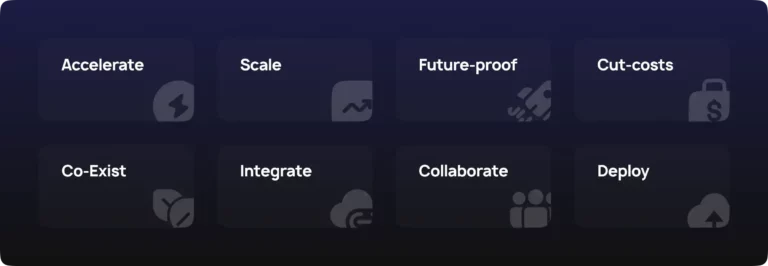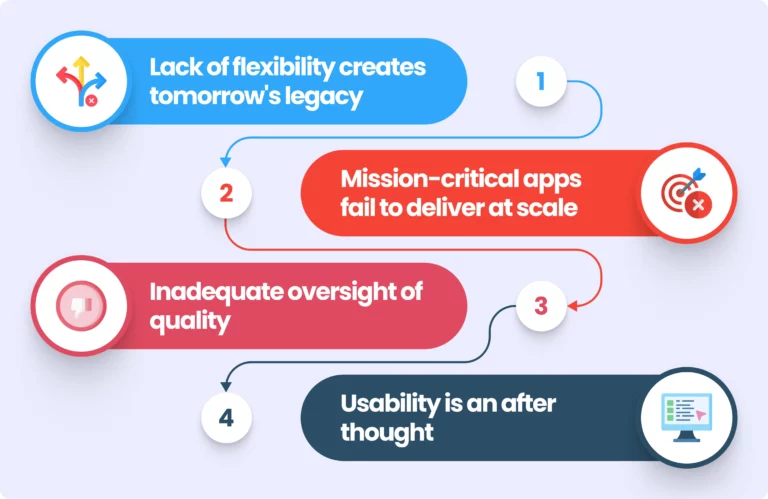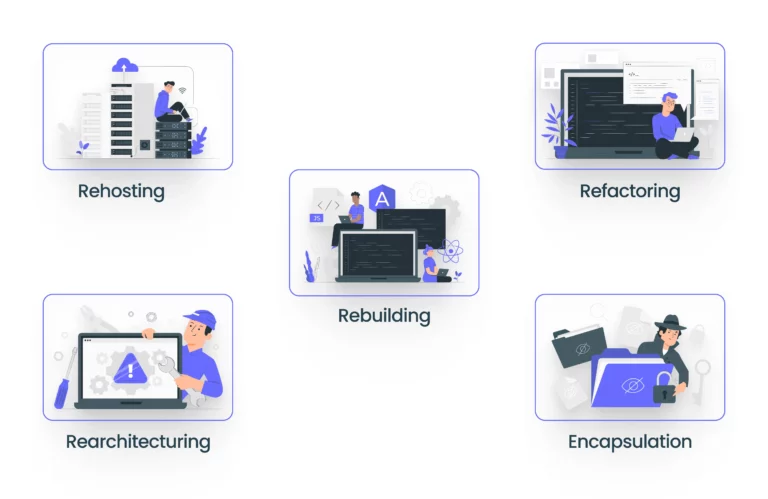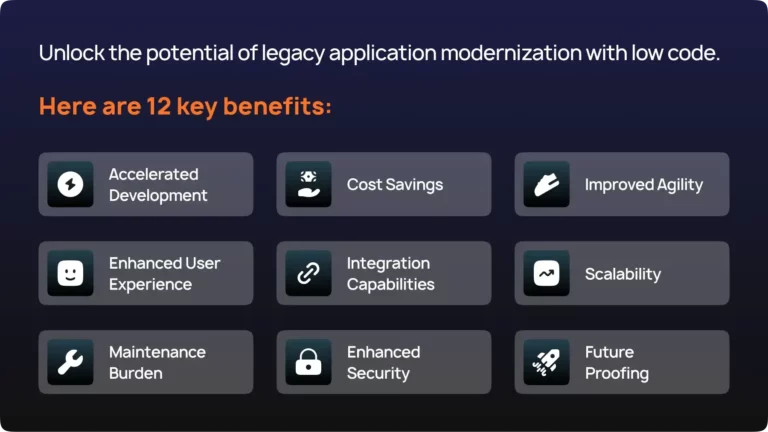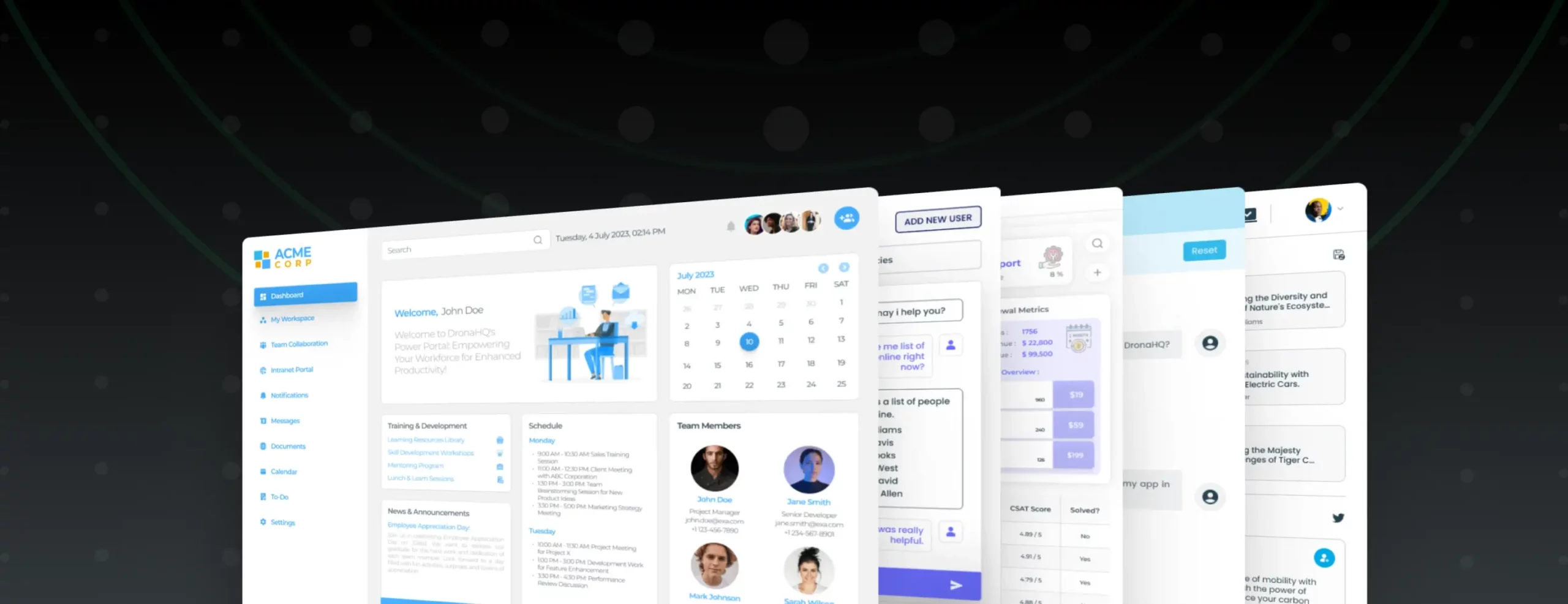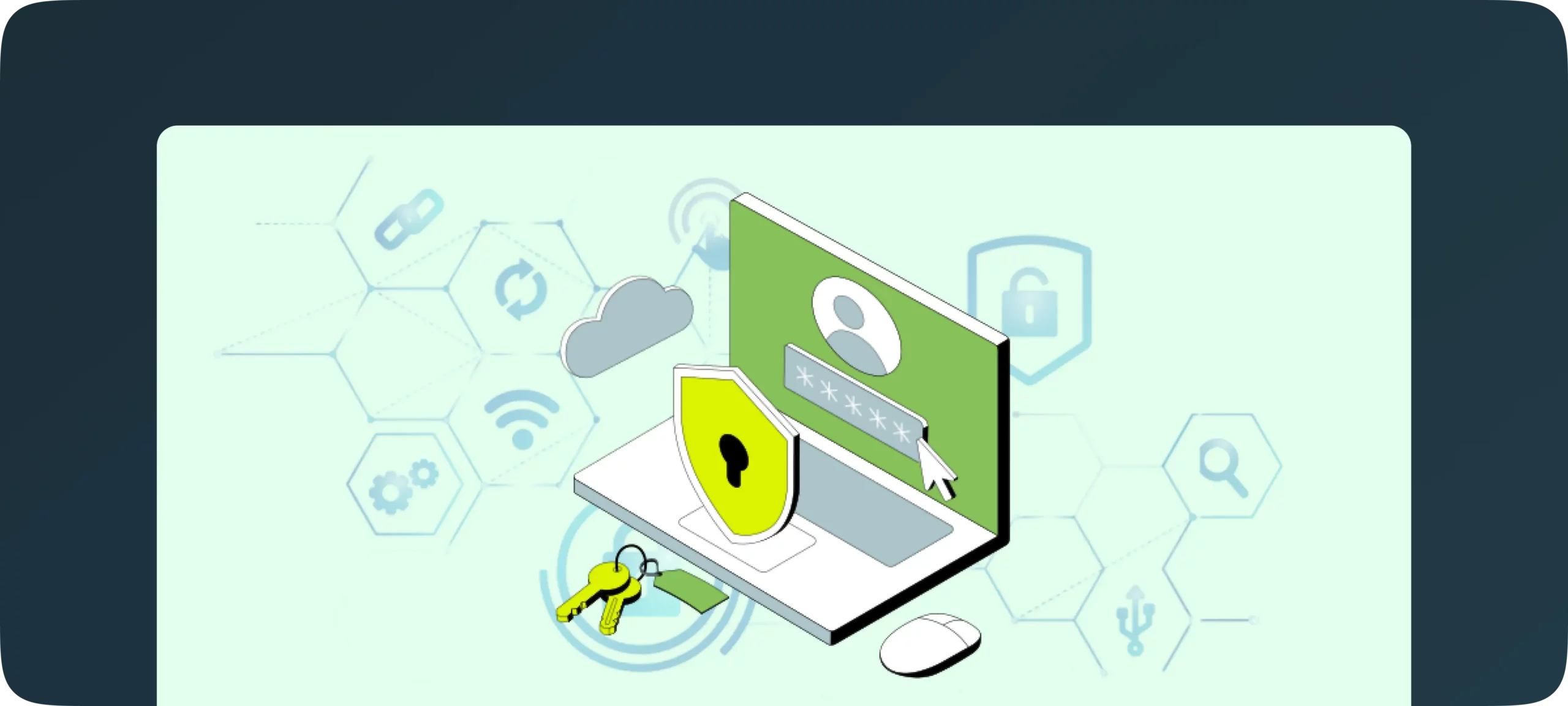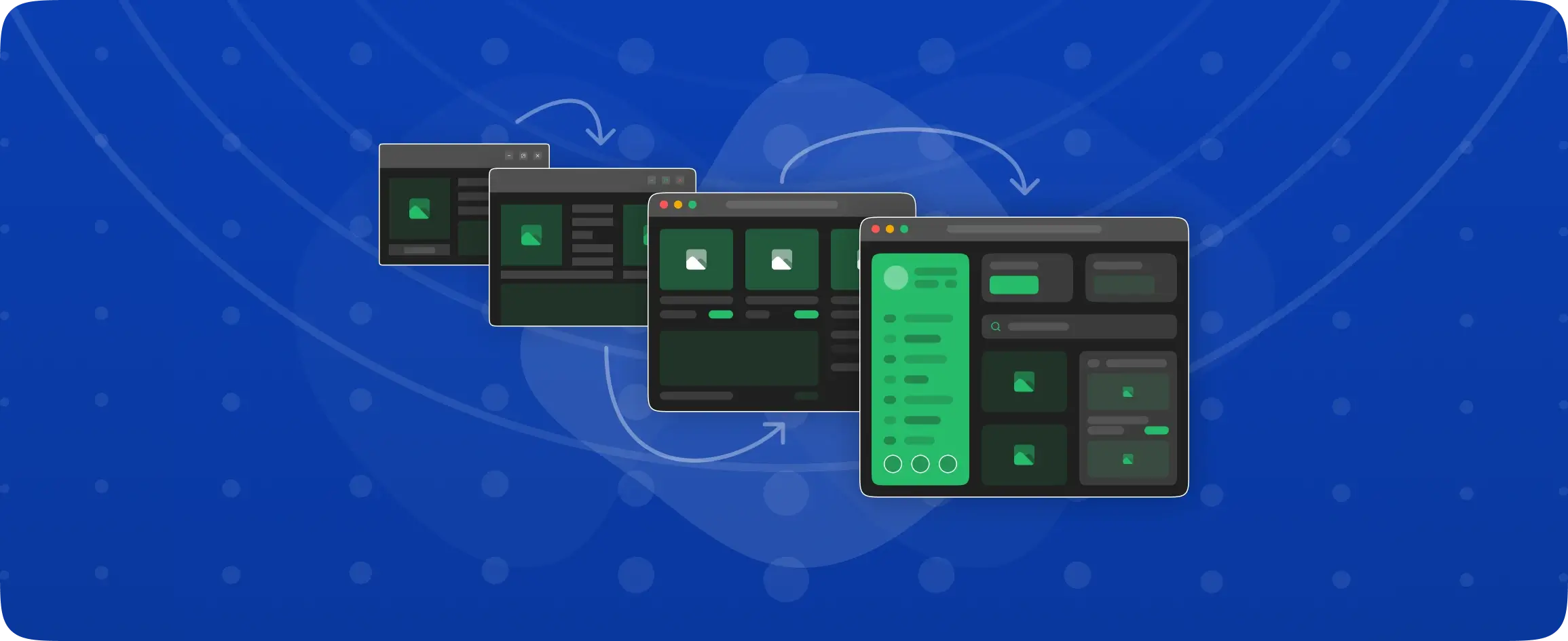

Legacy application modernization with low-code platforms
Legacy enterprise applications have run their course. The app modernization market is expected to reach $32 billion in the next three years.
If you need to modernize legacy applications, the best approach depends on the problem you’re trying to solve. – Gartner.
Traditionally, modernizing legacy applications has come with a heavy set of challenges. Today, we explore the low-code approach to modernize legacy applications.
What is a Legacy Application?
Legacy applications or systems, according to Gartner, are technology solutions that play a vital role in the daily operations of an organization. However, replacing these systems with newer technologies poses a major challenge for information systems professionals. As businesses undergo technology upgrades or changes, ensuring compatibility with existing legacy systems and data formats becomes crucial.
Legacy systems have a number of key characteristics:
- Restrained functionality,
- Security concerns,
- Outdated UI,
- Poor user experience,
- Too many ‘hacky’ code and integrations
- Not in sync with current workflows,
- Lack of integration with essential tools.
Legacy systems often prove to be more problematic and costly than their benefits justify. A staggering 75% of the federal government’s $80 billion IT budget is allocated toward maintaining legacy systems, some of which are over 25 years old.
These outdated systems hinder businesses by monopolizing a significant portion of their IT budget, tethering them to obsolete platforms that fail to meet modern requirements and impede organizational agility.
What is Legacy Application Modernization?
Legacy modernization is a strategic approach that balances the need for system improvement with the preservation of essential data and processes. By carefully assessing the specific requirements and limitations of each legacy system, organizations can identify and implement targeted modernization efforts that deliver significant benefits while minimizing disruption.
However, it is not as straightforward.
In certain cases, the existing legacy system may be closely connected to internal processes, making a complete transition to a new platform impractical. There are instances where a suitable modern alternative does not exist, leaving organizations with limited choices.
Organizations often choose to retain legacy systems as replacing these systems carries the risk of data loss, which may be deemed unacceptable.
In situations where complete replacement is not feasible, legacy application modernization focuses on selectively replacing, updating, or modifying specific components within the system. This entails extracting critical components while introducing modernized elements to the remaining infrastructure.
By 2027, the global application modernization tools market is projected to reach a valuation of $36.86 billion because the requirement for digital transformation is driving the increasing demand for application modernization tools.
A straightforward example of legacy modernization would be enhancing the user experience and functionality by designing a more intuitive and user-friendly front-end interface while retaining the underlying legacy backend system, such as a spreadsheet. Check our guide on how to build a custom app on top of your spreadsheet.
Benefits of Legacy Application Modernization
Persisting with legacy systems can pose significant challenges for both your team and your customers. However, the process of modernizing legacy applications offers a solution that reverberates positively throughout your entire digital ecosystem.
- Simplified Management and Maintenance: Modernized systems are easier to manage and maintain, reducing IT costs and lessening dependence on outdated technologies.
- Enhanced Automation and Process Efficiency: By embracing modernization, organizations can automate tasks more effectively, leading to streamlined processes and improved operational efficiency.
- Improved Technical Integrations and Data Management: Modernized applications facilitate better integration with other systems and offer improved capabilities for managing and leveraging data effectively.
- Access to Scalable SaaS Applications: Modernization opens the door to more scalable Software-as-a-Service (SaaS) solutions, empowering organizations to adapt to changing business needs more readily.
- Enhanced Application Performance: With modernization comes improved application performance and speed, ensuring smooth operations and enhanced user experiences.
- Agility to Meet Evolving End-user Needs: Modernized technology enables organizations to respond more efficiently to evolving customer requirements, fostering agility and adaptability in the face of change.

Modernize your legacy application with DronaHQ low-code
Get started for free →Challenges with Legacy Application Modernization
1. Lack of flexibility creates tomorrow’s legacy:
Legacy systems lack the flexibility required to adapt to changing operational needs. Organizations need to avoid creating new systems that will become tomorrow’s legacy. Low-code platforms provide a solution by enabling the development of modern, agile architectures. Microservices-based architectures facilitate the creation of autonomous apps and services that can be easily recombined and shared, allowing for fast and frequent change cycles. Choosing a future-proof low-code platform ensures maintainability and avoids the accumulation of unmaintainable apps or machine-generated code.
2. Mission-critical apps fail to deliver at scale:
Many core legacy systems struggle to deliver the required performance at scale. To address this, organizations should select a low-code platform that offers cloud-native architecture. Such platforms provide automatic failover capabilities, ensuring the continuous operation of mission-critical applications without performance issues.
3. Inadequate oversight of quality:
Legacy migration projects often involve large and complex applications, which can result in inadequate oversight of app quality. To prevent technical debt and improve long-term maintainability, organizations should choose a low-code platform that embeds automated quality, testing, and performance monitoring within the development lifecycle. This enables proactive monitoring and addressing of quality issues.
4. Usability is an afterthought:
Usability is often neglected in legacy systems, leading to a diminished return on investment (ROI). With low-code development, organizations can adopt a user-centric, design-thinking approach to create new solutions. By understanding users’ needs and the business context, organizations can close process gaps, deliver end-to-end solutions, and drive substantial productivity gains. Low-code platforms that involve the business in the design process ensure app usability and success.
Types of legacy migration projects
Legacy migration projects typically fall into two broad categories: lift-and-shift and business transformation.
1. Rehosting:
Move the entire legacy application to a new host, often a cloud-based platform, to enhance security, scalability, and accessibility. Rehosting allows organizations to leverage the benefits of cloud computing while minimizing disruptions to the existing application.
Eg. Migrating a legacy on-premises application to a cloud-based platform to improve scalability, reliability, and allow for easier management and maintenance of the application.
2. Refactoring:
Modernize the underlying structure and code of the legacy application while preserving its external behaviors. Refactoring improves maintainability, performance, and scalability without significant changes to the application’s features or functionality.
Eg. Upgrading the underlying codebase of a legacy application to utilize modern programming languages and frameworks, improving performance, maintainability, and extensibility while retaining the same user interface and functionality.
3. Rearchitecting:
Make substantial changes to the underlying architecture of the legacy application, such as migrating it to a different software architecture. Rearchitecting enables organizations to leverage modern technologies and capabilities, resulting in improved scalability, flexibility, and integration with other systems.
Eg. Transforming a monolithic legacy application into a microservices-based architecture, where different functionalities are broken down into modular services that can be independently developed, deployed, and scaled. This allows for greater flexibility, agility, and scalability.
4. Encapsulation:
Leave the legacy application in its original state and connect it to a new interface through an API. Encapsulation enhances functionality and usability without modifying the underlying code or deployment. This approach is particularly useful when the core functionality of the legacy application is still valuable, but a more modern user interface is desired.
Eg. Wrapping a legacy application with a modern user interface using APIs. This approach involves building a new front-end layer that interacts with the existing legacy application through APIs, providing users with a more intuitive and modern user experience while preserving the core functionality of the legacy system
5. Rebuilding or Replacing:
Rebuilding involves reconstructing some or all of the application from scratch while adhering to similar specifications while replacing entails building a completely new application with different scope and specifications. These approaches provide an opportunity to leverage modern development practices, technologies, and user experiences while addressing the limitations of the legacy system.
Eg. Building a new web-based application from scratch to replace a legacy application. The new application utilizes modern technologies, frameworks, and user experience principles, providing enhanced performance, responsiveness, and compatibility across devices.
Choosing the modernization approach with the highest effect and value
Rearchitecting often presents a middle ground, with moderate costs and risks. On the other hand, rebuilding or replacing can yield the best outcomes but often comes with higher costs and risks attached.
To make an informed decision, it’s essential to carefully weigh each option’s potential impact against its associated effort and risk. This strategic assessment enables organizations to identify the approach that will deliver the desired results with the optimal balance of investment and returns.
However, modernization doesn’t always necessitate wholesale replacement. Before committing to any course of action, it’s imperative to explore all available options thoroughly. By doing so, organizations can make informed digital strategy choices that align with their goals and resources. This process sets the stage for the exploration of innovative solutions, such as leveraging low-code platforms, to achieve efficient and effective legacy modernization.
Using low-code for legacy application modernization

Low-code platforms give developers a visual way to write code for legacy app modernization. It allows them to drag and drop reusable components and write custom code on top of it, as needed. This approach enables you to:
As per Gartner’s forecast, the demand and use of low-code platforms are increasing and will enhance legacy application modernization efforts.
About 35 percent of government legacy applications will be replaced by solutions developed on low-code application platforms by 2025.
Also, the multidisciplinary teams will be responsible for maintaining these apps.
Modernizing legacy systems using low-code technology
There are a number of ways that low code can be used to modernize legacy systems. One approach is to create a new application that interfaces with the legacy system. This can be done using APIs or other integration methods. The new application can then be used to add new features or functionality to the legacy system, without the need to modify the legacy code.
“As we examine legacy systems, we often encounter the challenge of excessive software sprawl, leading to decentralized processes with company-wide ramifications. Take spreadsheets, for instance. Despite its longevity, it lacks relational functionality, resulting in scattered data and integrity issues. And traditional databases, while advanced, lack user-friendliness.
This dilemma forces businesses to choose between advanced functionality in complex databases and the limited but familiar features of spreadsheets. With our no-code database featuring a spreadsheet-like interface, we bridge this gap by offering advanced functionality and familiarity, establishing a single source of truth for teams and businesses of all sizes,” shares Hiram Núñez, Product Marketing Manager at Baserow.
Another approach is to refactor the legacy code. This involves rewriting the code in a more modern format, using object-oriented programming or other techniques. This can make the code more maintainable and scalable, and it can also make it easier to integrate with new applications.
1. Replacement and rebuilding:
Rebuilding and replacing legacy systems have traditionally been effective but costly strategies for modernization. However, with the advent of low-code tools like DronaHQ, the process has become faster and more affordable. Businesses can now rebuild and replace tools in a matter of minutes, reducing the barriers to modernization.
A government agency used low code to modernize its legacy core system. The old system was no longer meeting modern security standards and couldn’t keep up with continuously changing legislation. Using a low-code platform they could replace the legacy system in just 6 months. The new system is now more secure, efficient, and accurate.
2. Extension:
In the past, businesses turned to refactoring or rearchitecting legacy tools to add new functionality, considering it a cost-effective approach. Re architecture could be needed for better data structure, APIs, or architecture, but frontend building time can be reduced to less than half using low code builders, thus helping legacy migration. Simple single-function applications can be built quickly and connected to existing databases or deployed as extensions to legacy platforms, enhancing functionality and workflows. If your existing legacy tools do not require extensive re-architecture – modern low code tools help businesses quickly build UI and frontend.
A chemical product manufacturer used low code to digitalize its internal operations. The company was facing challenges in its manufacturing operations due to a reliance on legacy systems and manual processes. Low code allowed the firm to build custom apps to supplement or replace legacy systems without disrupting the core functionality. This resulted in fully digitalized solutions such as a Raw Material Management System and Quality Management System.
3. Encapsulation:
Low-code development is particularly effective for building interfaces in this context. Instead of struggling with off-the-shelf solutions or expensive custom development, low-code development offers deployable interfaces in minutes, making this type of modernization cost-effective.
An ITeS player, used low-code technology to encapsulate their legacy CRM system, adding a modern and intuitive interface while preserving core functionality, resulting in improved user experience and operational efficiency.
4. Hybrid approaches:
Hybrid approaches involve combining multiple modernization strategies to achieve desired outcomes. For example, rehosting certain elements of legacy apps to improve security and then utilizing strategies like legacy application re-platforming to enhance functionality. A common example is migrating legacy datasets to a modern, secure host and simultaneously rebuilding or replacing other elements of the legacy application to effectively manage and utilize this data. Low-code builders provide extensive support for different types of existing databases, enabling businesses to quickly build improved interfaces and connect them to their existing data, regardless of the hosting environment.
Michael Udinski, Developer Advocate Lead @ Xano shared “We have observed a significant positive effect among our major clients who have integrated Xano into their operations. Developers can iterate software at a faster pace without compromising capabilities. Additionally, cross-functional teams can work together and be empowered as citizen developers, all within the collaborative, common environment of Xano.”
These four strategies demonstrate the power of low-code technology in modernizing legacy apps. With low-code tools, businesses can overcome the challenges of legacy modernization, making the process faster, more cost-effective, and more efficient. By leveraging the capabilities of low-code development, organizations can unlock the full potential of their legacy systems and embrace the benefits of modern technology.
Top low code platforms for legacy modernization
No-code / Low-code app builder:
These platforms provide visual development interfaces and pre-built components that allow users to quickly create modern web and mobile applications. They enable legacy systems to be transformed into user-friendly, scalable applications without extensive coding. This helps in streamlining processes, improving user experience, and integrating new functionalities.
1. Outsystems
2. Mendix
3. Zoho Creator
4. PowerApps
5. DronaHQ
No-code / Low-code backend:
These tools offer backend development capabilities without the need for extensive coding. They simplify the process of building and managing APIs, databases, and server-side logic. Legacy systems can be integrated with modern APIs and databases, enabling smoother data flow and supporting the integration of new features and technologies.
1. Xano
2. N8n
3. Backendless
4. Visual LANSA
No-code / Low-code database:
These platforms provide intuitive interfaces for designing and managing databases. They allow users to create custom database structures, import data from legacy systems, and build relationships between different data entities. Legacy data can be migrated and transformed into a more accessible and structured format, supporting efficient data management and analysis.
1. Baserow
2. Airtable
3. Stackby
4. Boomi
5. MuleSoft
No-code / Low-code API tools:
These tools assist in creating and managing APIs with ease. They allow for the documentation, testing, and monitoring of APIs. During legacy modernization, these tools can be utilized to expose legacy functionalities as APIs, ensuring seamless integration with other systems and enabling the development of new applications that leverage legacy capabilities.
1. Postman
2. Swagger
3. Apiary
4. PrestoAPI
No-code / Low-code integration:
These integration platforms automate the connection and workflow between various systems and applications. They enable legacy systems to integrate with modern tools, ensuring data synchronization, process automation, and real-time updates. Legacy applications can be connected to new applications and services, facilitating a more cohesive and efficient modernized ecosystem.
1. Zapier
2. Make
3. IFTTT
4. PhixFlow
Compare top low code app development platforms >
The benefits of using low code for legacy system modernization
Based on your low code vendor of choice, there are a number of benefits to using low-code for legacy system modernization. The most important ones include:
1. Reduced development time and cost: Low-code platforms can significantly reduce the time and cost of developing new applications. This is because they do not require extensive coding, which can be a major bottleneck in traditional development processes.
2. Improved agility: Low-code platforms make it easier to make changes to applications, which can help businesses to be more agile. This is important in today’s rapidly changing business environment.
3. Increased flexibility: Low-code platforms give businesses more flexibility in how they develop and deploy applications. This is because they do not require the use of a specific programming language or framework.
Low-code platforms can be a valuable tool for modernizing legacy systems. They can help to reduce development time and cost, improve agility, and increase flexibility. When choosing a low-code platform for legacy system modernization, it is important to consider the features and functionality of the platform, the ease of use, and the support for legacy systems.
How DronaHQ low code can help migrate or modernize your existing legacy systems?
DronaHQ Low-Code offers a transformative approach to modernizing legacy systems with a focus on enhancing user experience and achieving future-proof flexibility. Our low-code platform empowers organizations to create comprehensive web and mobile user interfaces that seamlessly integrate with legacy systems, enabling a smoother migration process. With DronaHQ Low-Code, you can leverage drag-and-drop features to quickly assemble pre-built UI components and design themes, ensuring a visually appealing and intuitive user interface.
We understand the importance of building a system that can adapt to changing needs, ensuring that the solutions developed today won’t become outdated tomorrow. By transitioning your legacy system to the DronaHQ low-code platform, you can simplify the migration journey and unlock the full potential of your applications.
Experience the power of low code for legacy modernization by signing up for a free demo today and witnessing how DronaHQ can automate your business operations and drive digital transformation throughout your organization.
FAQs:
What are legacy systems?
Legacy systems, also known as legacy software, are software applications or systems that have been in use for a significant period and continue to serve a vital purpose within an organization. These systems are often considered mission-critical as they play a crucial role in day-to-day operations or support essential business functions.
What sets legacy systems apart is their connection to specific operating systems or hardware types, resulting in vendor lock-in. These systems are tightly integrated with the underlying technology stack, making them challenging to migrate or replace without significant effort and cost.
Over time, the hardware infrastructure supporting legacy systems may become outdated or unsupported. While the software remains functional and necessary, the hardware it relies on becomes increasingly difficult to maintain. Despite the challenges, organizations often retain legacy systems due to their proven reliability and complexity that makes replacing them a complex and expensive endeavor.
What is legacy application modernization?
Modernizing legacy applications involves converting out-of-date software applications to more current, effective ones. This entails updating the application’s technological stack, revamping or replacing its architecture, and enhancing its functionality to satisfy present-day business requirements. Modernizing a legacy application aims to increase scalability, decrease maintenance costs, and enhance performance, security, and usability.
What is an example of legacy modernization?
Here are some of the top legacy modernization examples:
Cloud Migration: Moving apps and data from on-premises infrastructure to a cloud-based environment is required to migrate traditional systems to the cloud. This modernization method can offer high availability, security, scalability, and cost savings.
Re-platforming: Re-platforming is the process of migrating an application to a new platform without altering the code that runs on that platform.
Microservices Architecture: Breaking down huge, monolithic programs into smaller, independent services that can be created, deployed, and managed independently is the concept of a microservices architecture. This modernization strategy offers greater agility, scalability, and flexibility.
Containerization: Application packaging into containers that can be used in different settings is known as containerization. This modernization method offers efficiency, scalability, and portability.
These legacy modernization examples can also be considered as the top legacy modernization trends followed by top-level enterprises. Legacy application modernization is, therefore, a strategy to increase the functionality, security, and efficiency of legacy systems, allowing organizations to remain competitive and satisfy current business objectives.
Why is it so difficult to modernize legacy IT systems?
1. Compatibility with new technologies – Due to their age, legacy systems may not be compatible with newer systems and may require the creation of connectors or APIs from scratch. Even if these are built, the resulting functionality may not meet requirements, necessitating significant costs, efforts, and analyses.
2. Data Migration – Converting data from legacy systems to a readable format for use in new systems can be challenging, often resulting in data loss or corruption. A separate program or app may be needed to convert the data to a readable format for use in new systems, and the same app must convert the data back to legacy format if necessary. However, this approach is complex and may increase the likelihood of data loss.
3. Lack of documentation – Inadequate documentation makes it difficult to comprehend the process flow and interconnections between programs, as well as the reasons for writing code in a specific manner.
4. Security and compliance risks – As legacy systems lose their warranty and support, fixing vulnerabilities becomes increasingly challenging and may require innovative methods to cover the gaps or mask the issues
5. Business Continuity – The legacy systems were created without taking into account modern issues such as scalability, flexibility, and changing regulatory requirements, resulting in significant expenses to analyze and re-architect them.
6. Availability of resources – there are two distinct factors to consider here: a) employee resistance to change and b) scarcity of individuals with knowledge of such systems in the market. While managing the first issue might be easier and can be achieved at a slower pace, building knowledge from scratch to handle the latter issue can be much more complicated.
What are the core functionalities of a low-code platform that make legacy system migration a breeze?
1. Visual Development: Low-code platforms provide visual development capabilities, allowing users to design and develop applications through intuitive drag-and-drop interfaces. This eliminates the need for extensive coding, making it easier for developers and citizen developers alike to migrate legacy systems.
2. Rapid Application Development: Low-code platforms enable accelerated application development by providing pre-built components, templates, and reusable modules. This streamlines the migration process by reducing the time and effort required to build and configure new applications.
3. Integration Capabilities: Legacy system migration often involves integrating with existing systems and data sources. Low-code platforms offer built-in integration capabilities, including connectors, APIs, and data mapping tools, simplifying the process of connecting with legacy systems and migrating data.
4. Multi-Channel Deployment: Low-code platforms support multi-channel deployment, allowing applications to be deployed across various devices and platforms, including web browsers, mobile devices, and desktops. This flexibility ensures seamless migration of legacy systems to modern environments without sacrificing accessibility.
5. Workflow Automation: Low-code platforms feature workflow automation capabilities that enable the automation of manual processes, reducing dependency on legacy systems and improving operational efficiency. This automation simplifies the migration process by eliminating redundant steps and optimizing workflows.
6. Scalability and Flexibility: Low-code platforms are designed to be scalable and flexible, accommodating the evolving needs of organizations. This allows for the seamless scaling of applications during the migration process and future growth, ensuring that the migrated legacy system can adapt to changing requirements.
7. Collaboration and Governance: Low-code platforms facilitate collaboration between developers, business users, and stakeholders through features like real-time collaboration, version control, and role-based access control. This promotes effective communication and ensures proper governance throughout the legacy system migration journey.
By leveraging these core functionalities, low-code platforms empower organizations to streamline the migration of legacy systems. They provide the necessary tools and capabilities to simplify development, integration, deployment, automation, and collaboration, making the process of migrating legacy systems more efficient, cost-effective, and less reliant on complex coding.
Why should I modernize my applications?
Modernizing your applications offers several compelling benefits and advantages:
1. Enhanced user experience: Modernized applications provide a superior user experience compared to legacy systems. They feature intuitive interfaces, streamlined workflows, and improved usability, resulting in higher user satisfaction and increased productivity.
2. Improved efficiency and productivity: Modern applications are designed to optimize processes and workflows, leading to enhanced efficiency and productivity. They can automate manual tasks, eliminate redundant steps, and provide real-time access to relevant information, enabling employees to work more efficiently.
3. Scalability and Flexibility: Legacy systems often struggle to accommodate growing business needs and evolving technological advancements. Modernizing your applications allows for scalability, ensuring they can handle increased data volumes, user loads, and changing business requirements. Additionally, modern applications are built with flexibility in mind, allowing for easier integration with new systems and technologies.
4. Enhanced security: Legacy systems are more susceptible to security vulnerabilities as they may lack the latest security measures and updates. Modernizing your applications enables you to incorporate robust security features, encryption protocols, and authentication mechanisms, mitigating the risk of data breaches and ensuring compliance with industry regulations.
5. Cost savings: Legacy systems can be expensive to maintain, with high maintenance and operational costs. Modernizing your applications can lead to cost savings in the long run by eliminating the need for outdated infrastructure, reducing maintenance efforts, and improving overall operational efficiency.
6. Integration and Interoperability: Modern applications are designed with integration capabilities, allowing them to seamlessly connect with other systems, APIs, and third-party services. This promotes interoperability, data sharing, and collaboration across different departments, systems, and platforms.
7. Competitive advantage: By modernizing your applications, you gain a competitive edge in the market. Modern applications enable you to respond to customer demands more effectively, adapt to market trends, and innovate faster. This positions your organization as technologically advanced, agile, and capable of delivering exceptional products and services.
